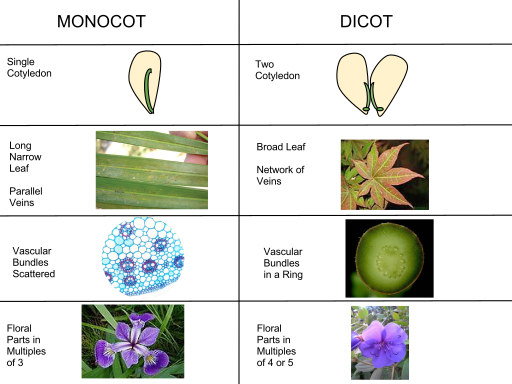The kingdom plantae is divided into four main phyla or Division
(i) Thallophyta (algae)
– They are simple microscopic plant
– They have no true root, stem and leaves
– They are found in aquatic habitat
-They are autotrophic plant i.e. They can synthesize their own food
– They reproduce both by asexual means and sexual means
– They have cellulose cell wall
– Many of them are pigmented such as red, blue, brown in addition to chlorophyll.
– Some are filamentous (algae) and the cells are not differentiated into tissue
(ii) Bryophyte (Moss and liverwort)
– They are non-vascular multicellular plant
– They have chlorophyll as the only photosynthetic pigment
– They are terrestrial but grow in moist environment
– Their body is differentiated into stem-like and leaf-like structure but no true root, stem and leaves
– They have no vascular tissue therefore they are unable to transport food and material round the body
– They reproduce asexually by means of spores while sexual reproduction by gametes and it takes place in water
– They exhibit what is called alternation of generation.
Division Pteridophyta (ferns)
– Their body is divided into true root, stem and leaves
– They have well developed vascular bundles comprising of xylem and phloem
– The underground stem is rhizome
– They reproduce by means of spores
– They need water of sexual reproduction which is by gametes formation
– The plants are mostly terrestrial while few are aquatic
– They exhibit alternation of generation
– They have asexual reproductive organ called sori while the sexual reproductive organ is heart- shaped called prothalus
SPERMATOPHYTA
– They are seed bearing plant
– They have well-developed vascular bundles
– They are well-adapted to terrestrial habitat and they are the most successful land plants
The Spermatophyta are divided into two:
(i) Division Gymnospermatophyta or Coniferophyta
– They are large plant with well-developed vascular bundle with true root, stem and leaves
– Their leaves are green in colour, small and needle-like
– Their naked seeds are born in cone because there is no ovary and no fruit
(ii) Division Angiospermatophyta
– They possess true flowers for sexual reproduction
– They have well-developed true root, stem and leaves
– They have well-developed vascular bundles
– Seeds and fruits are produced after fertilization and the seed are enclosed within the ovary
– They are terrestrial but some are aquatic
– They are terrestrial but some are aquatic
The Angiospermatophyta is divided into two classes
- Monocotylenoneae (Monocot)
- Dicotyledoneae (Dicot)

| Monocotyledoneae | Dicotyledonea |
| i. Leaves have parallel veins | Leaves have network veins |
| ii. Flowers are generally dull in | colour Flowers are bright in colour |
| iii. Embryo has one cotyledon (one seed Leaf) | Embryo has two cotyledons (two seed- leaves) |
| iv. The size of cortex is narrow | The size of the cortex is wide |
| v. It has fibrous root system | It has tap root system |
| vi. Cambium is absent in the stem | Cambium is present in the stem |
| vii. Vascular bundles are scattered all over the ground tissue | Vascular bundle are arranged in a ring of cambium |
| Example Maize, palm tree, grasses | Examples are Mango, Orange. |
Read our disclaimer.
AD: Take Free online baptism course: Preachi.com 